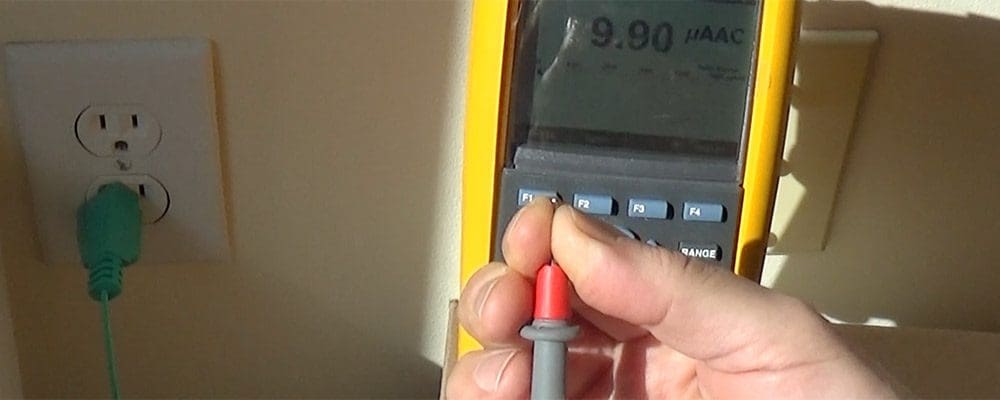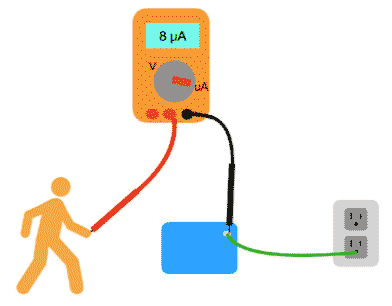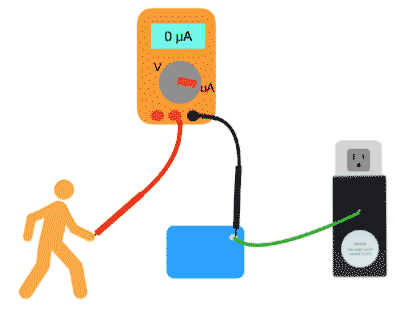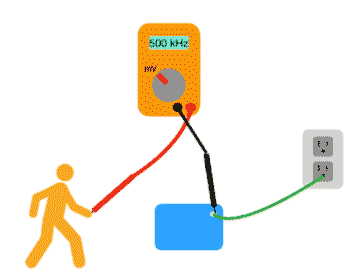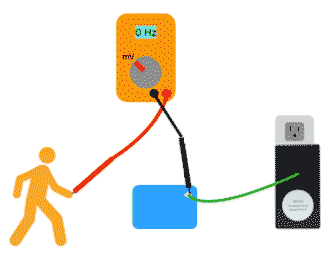There are three areas that the NCB addresses. It stops contact currentDefinition and Basic Concept Contact current refers to the electrical current that flows through a person’s body when they come into physical contact with an object that is electrically charged...., reduces dirty electricityDirty Electricity, also known as electrical pollution, refers to the presence of irregularities or distortions in the normal electrical current within a wiring system. These distortions, which deviate from the..., and ensures an effective ground-fault path.
In this post, we explain how you can verify all of these functions.
Stopping Contact Current
With the power"Power" in a scientific context refers to the rate at which work is done or energy is transferred. In simpler terms, it's how fast something is using energy. For example,... on to the outlet, test it with an outlet tester to confirm it is wired correctly.
Using a multimeter (and it is best to use a Fluke 287 or Fluke 289) first check the amount of contact current you are exposed to from your mat or grounding system.
Here are the steps:
- Plug in your grounding mat to an outlet.
- Set the Fluke 287 to μA. Red lead base in mA/μA. Black lead base in theCommon.
- Hold the black lead tip on the grounding mat metal connector.
- Hold onto the tip of the red lead.
- Next, with the NCB in the outlet, plug in the grounding mat to the NCB.
The Fluke multimeter will tell if there is current flowing between your body and the grounding mat.

Want to Slash Your EMF Health Risks?
Want to Slash Your EMF Health Risks?
Good! Learn the one small change you should make right now.
If the number on the Fluke is less than 1 μA you are being protected and the NCB is working.
Expect under some circumstances, some flickering of current below 0.1 μA. The Fluke shows two decimal points to the right of 1 μA (0.00) and is quite sensitive.
At times, it is good to see some random pulses to ensure the Fluke is working (good batteries).
If there is more than 1 μA of current, ensure the internal NCB dial is turned all the way to the right, clockwise (see here for more information on how to use the NCB dial).
Watch here as NCB Inventor Andrew McAfee demonstrates how to perform this test.
Stopping Dirty Electricity
Understand that the Stetzerizer or Greenwave EMI Dirty Electricity testing equipment do not test the equipment grounding conductorThe term "conductor," in the context of electromagnetic radiation, refers to materials or substances that allow for the efficient passage of electromagnetic energy, including both electric currents and electromagnetic fields..... The Fluke 287 can be an effective tool at showing high frequency"Frequency" in the context of electricity, Electromagnetic Fields (EMF), and wireless communication, can be thought of as the number of times something happens in a second. Specifically, it refers to... noise on the equipment grounding conductor.
Have the red test lead base plugged into the Fluke volts hole and turn the Fluke dial to mV. The rest of the contact points and set up and process is same as before. On the Fluke device, push the button F1 “Menu” and use the directional arrows to move the check mark to Hz, then click F1 “Hz”.
See the frequencies that are present, first, without the NCB.
And then see the reduction, with the NCB.
Watch as NCB Inventor Andrew McAfee demonstrates how to perform this test:
For an added bonus, watch this video to see which buttons to push on your Fluke to get a trend recording. The trend can show the before and after NCB results.
Confirming the NCB Will Trip a Breaker
This is a potentially dangerous test and should not be attempted unless you have an electrician or qualified person setting it up.
Breakers in the panel are highly suspect and may not work. My NCB may be working fine but your breaker is busted. This is great test for them both and is a two-for-one (if you’ve ever wondered if your breakers are working!). GFCI outlets are also suspect and I provide a way to test them with the NCB after this first test.
This is the test for a normal outlet without a GFCI in the circuit or at the panel. Power on. Insert outlet tester and check it is wired correctly. We don’t know if it is a switched outlet and a light switch controls it (like for lamps). Turn on/off any wall light switches in the room to see if the tester lights up or not. If it stays lit, we are good. You want the lights ON the tester.
Turn the breaker off to that outlet at the breaker panel. Outlet tester lights will be off confirming you have turned off the right circuit (test top and bottom receptacles to ensure both are off).
We are going to set up a dead-short, a direct connection between the hot and the groundIn the context of electricity, "ground" or "earthing" refers to a reference point in an electrical circuit from which voltages are measured, a common return path for electric current, or... (the outlet’s equipment grounding conductor). See picture for example.
Turn the breaker off to that outlet at the breaker panel. Use an outlet tester to confirm you have turned off the right circuit and outlet (test top and bottom receptacles to ensure both are off).
After confirming they are both off, then insert your home made, hot-to-ground dead-short contraption into the outlet.
Once again: this test is only for qualified personnel. If you are not 100% sure you know how to set this up and run this test, DON’T DO IT.
Connecting the hot directly to the equipment grounding conductor should instantly trip the breaker WHEN you turn the breaker back on. This is called a ground-fault.
Go to the breaker panel, and turn the breaker back on. It should INSTANTLY trip off, and the toggle switch should go to the middle setting, in between on and off.
That outlet should be now de-energized, tripped off by your overcurrent protection (breaker).
Under no circumstances should you touch the dead-short wires directly. Pull out the NCB and dead short contraption out of the wall and test the outlet to see if it is live. Your circuit breaker should have de-energized that outlet and it should be dead.
There are various ways to confirm the outlet is off. Use an outlet tester or lamp to see if it lights up (plug into both the top and bottom outlets as it could be a switched outlet).
This test represents an extreme example of where your grounding mat, canopy, grounded bed sheets made a connection with a cut lamp cord or other live source. There are numerous variations and levels of voltage and current possible, but we want to confirm the most obvious for your protection.
Now, unplug everything from the outlet. Go back and turn on the breaker. Turn it off fully, then back on. Test the outlet again with an outlet tester. It should light up and be working fine.
Watch to see NCB Inventor Andrew McAfee demonstrate how to perform this test.
Testing a GFCI
I recommend installing a GFCI outlet to the room or outlet that will used for the NCB. Home Depot has a nice instruction page and video on how to do this.
As you saw in the last testing video, the tripping conditions of some GFCI are unpredictable too. Use the outlet GFCI tester button, NOT the dead-short contraption to test the GFCI.
My kitchen GFCI trips with the NCB in full blocking mode, 500 kOhms, dial turned all the way to the right, clockwise.
My bathroom GFCI needs the dial turned down to below 20 kOhms. It does make sense from an Ohms law perspective.
V/R = I or 120V / 24,000 ohms = 0.005A or 5 mA the activation threshold for the GFCI.
V/I = R 120V / 0.005 A = 24,000 ohms.
This is just an ideal and we’ll see about the real world.
You can use the test points 1 and 3 (TP1 and TP3) for the black and read leads to adjust and measure the resistance"Resistance" is a fundamental concept in the field of electricity and electronics, central to understanding how electric circuits operate. It refers to the opposition that a material or a device... of dial resistor. This video demonstrates the three separate touch points inside of the NCB.
In the end, set the dial to the number that blocks enough current during normal usage and if needed, below 24,000 ohms for the added GFCI protection.
You now have the tools to test if the NCB, and your circuit protection devices, are working, or not.
